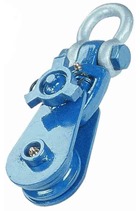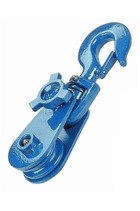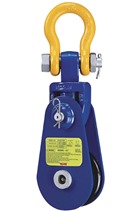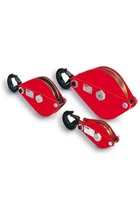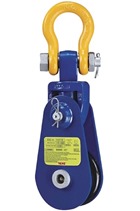A snatch block is a heavy-duty pulley inside a metal casing. It is primarily designed for handling heavy goods, working as a pulley point that can redirect the course of a winch line.
Snatch blocks are also used to increase the lifting or pulling capacity of wire hoists and winches. It's common for this method to produce a 100% increase in pulling or lifting capacity - be aware of the extra force this puts on fixing / anchor points.
Snatch blocks allow you to change the direction of a winch’s cable by off-setting the anchor point, allowing you to pull in a three-point motion. Sturdy and durable, snatch blocks are ideal for transferring loads over short distances and are commonly used in recovery situations.
When used in conjunction with a winch, a snatch block can increase the winch’s power considerably, allowing for a smoother, easier winching process.
How to use a snatch block
In order to understand how a snatch block works, imagine a fallen tree blocking a road. You have a winch on your truck, and you need to pull the tree out of your path.
Using another tree (one that's still standing) as an anchor point for your snatch block, you can feed a cable from your truck through the snatch block, then fasten it to the fallen tree.
The addition of the snatch block around the tree allows you to redirect the course of the winch, pulling the heavy obstacle to the side, out of the road, clearing your path.
Types of snatch block
Snatch block with hook - Normally used with wire rope hoists and winches during temporary applications.
Snatch block with shackle - Used in permanent and temporary rigging applications.
Swing block - Normally used with vehicle winches and 4 x 4 off-roaders.
Snatch block safety
Snatch blocks can be dangerous if used incorrectly, so it’s important to make sure you know what you’re doing.
When used in conjunction with a winch, a huge amount of force passes through the snatch block. In fact, the pressure on the line can be as much as twice that of the actual load being towed! If the pressure becomes too much and the block fails, the resulting slingshot effect can easily do a lot of damage.
With so much force resting on the snatch block, it’s imperative that the equipment is set up correctly and all components attached securely. This includes the anchor point itself. If the anchor point isn’t secure or can’t handle the pressure, this too could result in disaster.
If you have any other questions about our snatch blocks, please don't hesitate to contact SafetyLiftinGear for assistance. With such a wide range of snatch blocks available to buy and hire, we're confident that we can provide a solution that suits your requirements.








